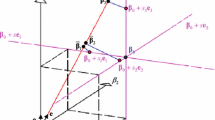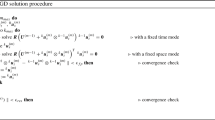Abstract
This paper presents in a unified framework the most representative state-of-the-art techniques on a posteriori error assessment for second order hyperbolic problems, i.e., structural transient dynamics. For the sake of presentation, the error estimates are grouped in four types: recovery-based estimates, the dual weighted residual method, the constitutive relation error method and error estimates for timeline-dependent quantities of interest. All these methodologies give a comprehensive overview on the available error assessment techniques in structural dynamics, both for energy-like and goal-oriented estimates.












Similar content being viewed by others
References
Babuska I, Rheinboldt WC (1978) Error estimates for adaptive finite element computations. SIAM J Numer Anal 18:736–754
Ladevèze P, Leguillon D (1983) Error estimate procedure in the finite element method. SIAM J Numer Anal 20:485–509
Zienkiewicz OC, Zhu JZ (1987) A simple error estimator and adaptative procedure for practical engineering analysis. Int J Numer Methods Eng 24:337–357
Paraschivoiu M, Peraire J, Patera AT (1997) A posteriori finite element bounds for linear-functional outputs of elliptic partial differential equations. Comput Methods Appl Mech Eng 150:289–321
Parés N, Bonet J, Huerta A, Peraire J (2006) The computation of bounds for linear-functional outputs of weak solutions to the two-dimensional elasicity equations. Comput Methods Appl Mech Eng 195:406–429
Cirak F, Ramm E (1998) A posteriori error estimation and adaptivity for linear elasticity using the reciprocal theorem. Comput Methods Appl Mech Eng 156:351–362
Prudhomme S, Oden JT (1999) On goal-oriented error estimation for elliptic problems: application to the control of pointwise errors. Comput Methods Appl Mech Eng 176:313–331
Ainsworth M, Oden JT (2000) A posteriori error estimation in finite element analysis. Wiley, New York
Ladevèze P, Pelle JP (2001) La maîtrise du calcul en mécanique linéaire et non linéaire. Lavoisier, New York
Stein E (2003) Error-controlled adaptive finite elements in solid mechanics. Wiley, New York
Ainsworth M, Oden JT (1997) A posteriori error estimation in finite element analysis. Comput Methods Appl Mech Eng 142:1–88
Gratsch T, Bathe KJ (2005) A posteriori error estimation techniques in practical finite element analysis. Comput Struct 83:235–265
Díez P, Parés N, Huerta A (2010) Encyclopedia of aerospace engineering, chapter error estimation and quality control. Wiley, New York
Rannacher R (2001) Adaptive Galerkin finite element methods for partil differential equations. J Comput Appl Math 128:205–233
Gallimard L, Ladeveze P, Pelle JP (2000) An enhanced error estimator on the constitutive relation for plasticity problems. Comput Struct 78:801–810
Ladevèze P (2001) Constitutive relation errors for fe analysis considering (visco-)plasticity and damage. Int J Numer Meth Eng 52:527–542
Ladevèze P, Moës N (1999) Adaptive control for finite element analysis in plasticity. Comput Struct 73:45–60
Ladevèze P, Moës N, Douchin B (2000) Constitutive relation error estimators for (visco)plastic finite element analysis with softening. Comput Methods Appl Mech Eng 176:247–264
Parés N, Díez P, Huerta A (2009) Exact bounds of the advection–diffusion–reaction equation using flux-free error estimates. SIAM J Sci Comput 31:3064–3089
Larsson F, Díez P, Huerta A (2010) A flux-free a posteriori error estimator for the incompressible Stokes problem using a mixed FE formulation. Comput Methods Appl Mech Eng 199:2383–2402
Parés N, Díez P, Huerta A (2008) Bounds of functional outputs for parabolic problems. Part I: exact bounds of the discontinuous galerkin time discretization. Comput Methods Appl Mech Eng 197:1641–1660
Parés N, Díez P, Huerta A (2008) Bounds of functional outputs for parabolic problems. Part II: bounds of the exact solution. Comput Methods Appl Mech Eng 197:1661–1679
Díez P, Calderón G (2007) Goal-oriented error estimation for transient parabolic problems. Comput Mech 39:631–646
Larson MG, Bengzon F (2008) Adaptive finite element approximation of multiphysics problems. Commun Numer Methods Eng 24:505–521
Larson MG, Soderlund R, Bengzon F (2008) Adaptive finite element approximation of coupled flow and transport problems with applications in heat transfer. Int J Numer Methods Fluids 57:1397–1420
Fick PW, van Brummelen EH, van der Zee KG (2010) On the adjoint-consistent formulation of interface conditions in goal-oriented error estimation and adaptivity for fluid-structure interaction. Comput Methods Appl Mech Eng 199:3369–3385
van der Zee KG, van Brummelen EH, Akkerman I, de Borst R (2011) Goal-oriented error estimation and adaptivity for fluid-structure interaction using exact linearized adjoints. Comput Methods Appl Mech Eng 200:2738–2757
Asner L, Tavener S, Kay D (2012) Adjoint-based a posteriori error estimation for coupled time-dependent systems. SIAM J Sci Comput 34:2394–2419
Li XD, Wiberg NE (1998) Implementation and adaptivity of a space–time finite element method for structural dynamics. Comput Methods Appl Mech Eng 156:211–229
Wiberg NE, Li XD (1999) Adaptive finite element procedures for linear and non-linear dynamics. Int J Numer Methods Eng 46:178–1802
Schleupen A, Ramm E (2000) Local and global error estimations in linear structural dynamics. Comput Struct 76:741–756
Thompson LL, He D (2005) Adaptive space–time finite element methods for the wave equation on unbounded domains. Comput Methods Appl Mech Eng 194:1947–2000
Lahiri S, Bonet J, Peraire J (2010) A variationally consistent mesh adaptation method for triangular elements in explicit lagrangian dynamics. Int J Numer Methods Eng 82:1073–1113
Aubry D, Lucas D, Tie B (1999) Adaptive strategy for transient/coupled problems. Applications to thermoelasticity and elastodynamics. Comput Methods Appl Mech Eng 176:41–50
Bangerth W, Geiger M, Rannacher R (2010) Adaptive Galerkin finite element methods for the wave equation. Comput Methods Appl Math 1:3–48
Bangerth W (1998) Adaptive Finite-Elemente-Methoden zur Lösung der Wellengleichung mit Anwendung in der Phisik der Sonne. PhD thesis, Ruprecht-Karls-Universität Heidelberg
Bangerth W, Rannacher R (1999) Finite element approximation of the acoustic wave equation: error control and mesh adaptation. East-West J Numer Math 7:263–282
Bangerth W, Rannacher R (2001) Adaptive finite element techniques for the acoustic wave equation. J Comput Acoust 9:575–591
Combe JP, Ladevèze P, Pelle JP (2002) Discretization error estimator for transcient dynamic simulations. Adv Eng Softw 33:553–563
Combe JP, Ladevèze P, Pelle JP (1999) Constitutive relation error estimator for transient finite element analysis. Comput Methods Appl Mech Eng 176:165–185
Ladevèze P, Pelle JP (2003) Estimation of discretization errors in dynamics. Comput Struct 81:1133–1148
Ladevèze P, Waeytens J (2009) Model verification in dynamics trough strict upper bounds. Comput Methods Appl Mech Eng 198:1775–1784
Waeytens J (2010) Contrôle des calculs en dynamique: bornes strictes et pertinents sur une quantié d’intérêt. PhD thesis, LMT-Cachan
Ladevèze P (2008) Strict upper error bounds for computed outputs of interest in computational structural mechanics. Comput Mech 42:271–286
Waeytens J, Chamoin L, Ladevèze P (2012) Guaranteed error bounds on pointwise quantities of interest for transient viscodynamics problems. Comput Mech 49:291–307
Verdugo F, Díez P (2012) Computable bounds of functional outputs in linear visco-elastodynamics. Comput Methods Appl Mech Eng 245–246:313–330
Fuentes D, Littlefield D, Oden JT, Prudhomme S (2006) Extensions of goal-oriented error estimation methods to simulation of highly-nonlinear response of shock-loaded elastomer-reinforcedstructures. Comput Methods Appl Mech Eng 195:4659–4680
Evans LC (1998) Partial Differential Equations. American Mathematical Society, Providence
Newmark NM (1959) A method of computation for structural dynamics. J Eng Mech 85:67–94
Eriksson K, Estep D, Hansbo P, Johnson C (1996) Computational differential equations. Studentlitteratur, Lund
Hughes TJR, Hulbert GM (1988) Space–time finite element methods for elastodynamics: formulations and error estimates. Comput Methods Appl Mech Eng 66:339–363
Hulbert GM, Hughes TJR (1990) Space–time finite element methods for second-order hypeerbolic equations. Comput Methods Appl Mech Eng 84:327–348
Johnson C (1993) Discontinuous galerkin finite element methods for second order hyperbolic problems. Comput Methods Appl Mech Eng 107:117–129
Johnson C (1990) Numerical solution of partial differential equations by the finite element method. Cambridge University Press, Cambridge
Díez P, Calderón G (2007) Remeshing criteria and proper error representations for goal oriented h-adaptivity. Comput Methods Appl Mech Eng 196:719–733
Zienkiewicz OC, Xie YM (1991) A simple error estimator and adaptive time stepping procedure for dynamic analysis. Earthq Eng Struct Dyn 20:871–887
Li XD, Zeng LF, Wiberg NE (1993) A simple error estimator and adaptive time stepping procedure for dynamic analysis. Commun Numer Methods Eng 9:273–292
Zienkiewicz OC, Zhu JZ (1992) The superconvergent patch recovery and a posteriori error estimates. Part 1: the recovery technique. Int J Numer Methods Eng 33:1331–1364
Zienkiewicz OC, Zhu JZ (1992) The superconvergent patch recovery and a posteriori error estimates. Part 2: error estimates and adaptivity. Int J Numer Methods Eng 33:1365–1382
Wiberg NE, Li XD (1994) Superconvergent patch recovery of finite-element solution and a posteriori L\(_2\) norm error estimate. Commun Numer Methods Eng 10:313–320
Li XD, Wiberg NE (1994) A posteriori error estimate by element patch post-processing, adaptive analysis in energy and L\(_2\) norms. Comput Struct 53:907–919
Wiberg NE, Bausys R, Hager P (1999) Adaptive h-version eigenfrequency analysis. Comput Struct 71:565–584
Rannacher R, Stuttmeier FT (1997) A feed-back approach to error control in finite element methods: application to linear elasticity. Comput Mech 19:434–446
Bangerth W, Rannacher R (2003) Adaptive finite element methods for differential equations. Birkhäuser, Berlin
Oden JT, Prudhomme S (2001) Goal-oriented error estimation and adaptivity for the finite element method. Comput Math Appl 41:735–765
Parés N, Díez P, Huerta A (2006) A subdomain-based flux-free a posteriori error estimators. Comput Methods Appl Mech Eng 195:297–323
Moitinho de Almeida JP, Almeida Pereira OJB (2006) Upper bounds of the error in local quantities using equilibrated and compatible finite element solutions for linear elastic problems. Comput Methods Appl Mech Eng 195:279–296
Almeida Pereira OJB, Moitinho de Almeida JP (2010) Dual adaptive finite element refinement for multiple local quantities in linear elastostatics. Int J Numer Methods Eng 83:347–365
Pled F, Chamoin L, Ladevèze P (2011) On the techniques for constructing admissible stress fields in model verification: performances on engineering examples. Int J Numer Methods Eng 88:409–441
Cottereau R, Díez P, Huerta A (2009) Strict error bounds for linear solid mechanics problems using a subdomain-based flux-free method. Comput Mech 44:533–547
Verdugo F, Parés N, Díez P (2013) Modal based goal-oriented error assessment for timeline-dependent quantities in transient dynamics. Int J Numer Methods Eng 96:483–509
Rafique A, Kapre N, Constantinides GA January (2012) A high throughput FPGA-based implementation of the lanczos method for the symmetric extremal eigenvalue problem. In: 8th international symposium on applied reconfigurable computing
Bathe KJ (1996) Finite element procedures. Prentice Hall, New York
Trefethen LN, Bau D (1997) Numerical linear algebra. Society for Industrial and Applied Mathematics, Philadelphia
Acknowledgments
Partially supported by Ministerio de Educación y Ciencia, Grant DPI2011-27778-C02-02 and Universitat Politècnica de Catalunya (UPC-BarcelonaTech), grant UPC-FPU.
Author information
Authors and Affiliations
Corresponding author
Rights and permissions
About this article
Cite this article
Verdugo, F., Parés, N. & Díez, P. Error Assessment in Structural Transient Dynamics. Arch Computat Methods Eng 21, 59–90 (2014). https://doi.org/10.1007/s11831-014-9096-x
Received:
Accepted:
Published:
Issue Date:
DOI: https://doi.org/10.1007/s11831-014-9096-x




